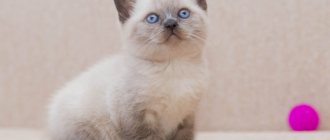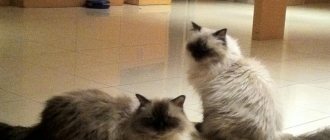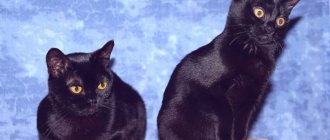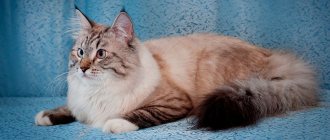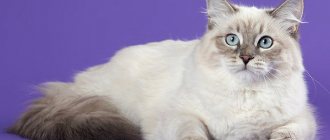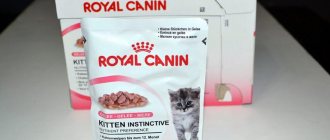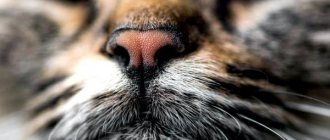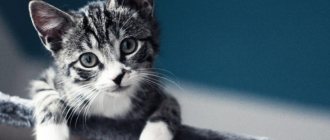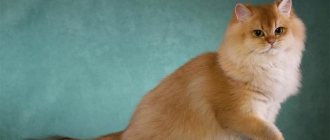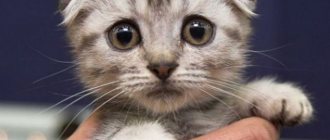1
Siamese and Persian were the first cat breeds to be officially registered. More than one modern breed began its history with them, in particular, color points. Siamese cats were brought to European soil in 1870. With their interesting color-point coat and sky-blue eyes, the Siamese conquered many people's hearts.
The British colorpoint coat, also called the Himalayan, is characterized by the Siamese coat color, which comes in a wide palette of tones and is extremely popular nowadays.
Determination of color
Color point is a derivative of a combination of two English words: color (color) and point (point). Its visual expression is characterized by the contrasting difference between the light body of the animal and the accentuated ends of the limbs.
The most typical representative of this class is the Siamese breed, from which, apparently, the entire selection line came.
The distinctive features of the color point color appear as follows:
- light monochromatic hair on the body;
- clearly visible darkening on the legs, tail and ears;
- a contrast mask on the muzzle that can spread over its entire surface or be located only in the nose area.
The color of the limbs and its saturation depend on additional reasons.
Interesting: All colorpoint kittens are born without signs of future pigmented areas, but they appear already in the first week of life.
Appearance of the British Shorthair cat
The description of the British Shorthair cat can begin with the fact that despite its rather large size, it has truly feline grace and elegance. This breed attracts with its beautiful, deep look and velvety coat, which is very pleasant to the touch and appearance.
If necessary, the British Shorthair can be a good hunter. The weight of representatives of the breed can range from four to eight kilograms.
He has fairly broad shoulders, a chest and a powerful body. The round and wide head has a short nose. The eyes are also round, the color of which depends on the type of breed and can be orange, blue or green.
The paws are small, but massive with thick claws. The tail has a rounded end, thickened at the base. The ears of British Shorthairs should be straight and erect, this indicates the purebred of the individual. The coat has a dense undercoat and is short and dense.
Color Dot Genetics
The CS gene is responsible for the characteristic non-standard coloring, which reacts to body temperature in its various places. Pigmentation appears in cooler areas around the extremities: paws, tail, ears and nose.
The dark pointed coat tone is passed on to the kitten from parents who have the recessive CS gene.
The next hereditary feature is the blue eyes of a cat, characteristic of albinos. It has been noted that the brighter this trait, the richer the tone of the fur on the mask and the more contrasting the difference with the color of the body - the structure of the main gene C suppresses darkening in parts with elevated temperatures, and the hairs on the limbs are controlled by the CS trait, which is activated in these places.
The final formation of a kitten's color occurs between six months and 10 months.
Interesting: In the future, even the weather and living conditions affect the color saturation - the cooler the air, the more contrasting the color-point pigmentation of the cat looks.
Color features
The color mask of the limbs in animals with acromelanism (incomplete albinism) varies depending on the base tone of the coat. It is never pure white, but lightens in harmony with the characteristics of the recessive CS gene.
Therefore, for example, the rich brown mask of a color-point cat accompanies a fawn shade, and red pigmentation stimulates varieties of the cream range of the color palette.
In total, the group combines about 20 different coloring options, from traditional dark to exotic lilac or wine.
Solid colors
The classification of color takes into account the characteristics of pigmentation, fixing them in the name.
Seal point (black)
Cats of this group are distinguished by a deep shade of black mask (sometimes with dark brown transitions), which also covers the areas of the limbs.
The coat on the body is light, in white, beige and cream colors.
Blue point (blue)
The pigment should be clearly visible against the background of the main color. The body coat is as close as possible to cool white, but the international standard also allows gray-blue.
It is important that the mask clearly contrasts with the body and does not have stretched transition zones.
Lilac point (lilac)
They are born almost white, but quickly lose this color. The main color is characterized by warm light purple tones, and a gray-pink mask covers the limbs.
In youth, the contrast is weakly expressed, but with age it gains pigment and is easily read on the coat.
Red point (red)
Another rare representative of the color point group of cats. The color tends from white to pink or peach pastel tones, and the points are expressed by orange-red markings.
Cinnamon point (cinnamon)
Perhaps the most unique color. Obtaining offspring with this color is an undeniable success for any breeder. And if the CS gene is added, then the value of victory increases a hundredfold.
The main coat on the body in warm shades of ivory is complemented by rich brown color-point pigmentation that extends into the red spectrum.
The problem is that this variant is easily overwhelmed by other species that suppress the cinnamon shade and transfer them to their own groups.
Chocolate point (chocolate)
The chestnut-brown color of the spots and the coat in shades of ivory is a rare combination that color point kittens can boast of.
Cream point (cream)
Delicate light cream color of the cat's body with acceptable variations in all shades of baked milk. The mask on the limbs is a thick chocolate color, contrasting, with clear boundaries of the pattern.
Interesting: Cream and red kittens often have problems with classification. They completely bloom only after a year of life. Therefore, at a young age, experts often question the color of, for example, a British pointing cat.
Feeding
It is acceptable to feed cats of this breed both natural food and industrial food. Since color points can be susceptible to allergies, food should be chosen carefully. The owner needs to focus on the preferences of the pet itself. There are often cases when a pet refuses meat and is ready to eat only industrial food. And, conversely, he may not recognize the latter, preferring raw meat and fish.
Important: when feeding ready-made diets, it is worth remembering that the cat vitally needs water. It must be available at all times. And with a natural type of feeding, it is necessary to add vitamin and mineral supplements to the diet from time to time.
Color Point Shorthair is a breed of cat bred on the basis of the Siamese. They have unique colors and specific character. They have good health and are easy to care for.
Tortoiseshells
Remarkable due to genetic characteristics is the combination of dark and reddish spots scattered throughout the body. In combination with acromelanism of color points, they lose their brightness and become poorly visible.
Seal cake point
Light beige coloring of the body and a deep dark mask of the limbs, combined with reddish tortoiseshell inserts.
Blue cake point
Pale blue coat, close to the cool gray-white spectrum, and blue-gray spots. The blue color-point color of tortoiseshell cats is complemented by faint cream shades.
Chocolate tortie point
The traditional warm, creamy color of the coat and the rich mask of the limbs are complemented by distinct reddish accents.
Lilac cake point
A kitten in lilac color is rare. Its standard characteristics (light base color and gray-pink pigmentation) are complemented by a tortoiseshell redness.
Cinnamon torty point
The cat's body has ivory-colored fur and a rich mask ranging from cream to light brown.
Interesting: Another distinctive feature of the color-point tortoiseshell is the paw pads and nose. They are two-tone, matching the shade of the adjacent coat.
Tabby point
A variety of dots in which a pigmented pattern is added to the main color. In this case, the mask does not cover the muzzle with a continuous fill, but is distributed symmetrically over it:
- the letter M on the forehead usually reaches the eye line or descends below it;
- spots in the roots of the mustache and in the lip area;
- the eyes are outlined with pigmented glasses;
- around the nose there is a contour to match the points.
This cat breed is also distinguished by its striped tail, on which the primary and secondary colors alternate.
Color point breeds
Not every cat can boast a pigmented variety of its breed. Targeted breeding concerns only a limited number of them.
Scottish
The main distinguishing feature of these cats is their folded ears. Small forward-curved ears with a curled tip have turned the Scottish Straight (especially with pointing spots) into a real four-legged brand.
Strong, harmoniously built, with good health and a calm character, the Scottish cat easily gets along with people.
British
The first British (at that time without a color-point mask) appeared at exhibitions a century and a half ago, although their ancestry is much older. The illustration of the Cheshire cat in the fairy-tale Alice was copied from a representative of this breed.
A large, graceful cat, with a lively look and velvety short-haired coat. An excellent companion, but only for one owner.
The British Color Point easily tolerates loneliness and jealously guards its own personal space. Does not allow familiarity and can be aggressive.
Persian
Champions in fur length among cats and owners of a characteristic flattened nose. Persia is considered the homeland of these creatures, from where they were brought to Europe. True, then they were distinguished only by long (up to 12 cm) wool.
The upturned nose of the Persian color-point is the result of the selection efforts of American breeders in the twentieth century.
Massive large body, placed on low strong paws. These cats are fluffy from the ears to the tip of the tail, with an intelligent, deep look from their wide-set eyes.
Persians are very sociable creatures, devoid of signs of obligatory dominance, characterized by a calm character and balanced psyche.
Neva Masquerade
The colorpoint mask caused the association with masquerade, and the mention of the Neva in the name refers to the place of the first selection. This is the youngest of the presented breeds, having a Russian Siberian cat as its ancestors.
Sturdy, strong, muscular animals of medium to large size. Semi-long coat in 6 color-point colors.
Affectionate and sociable, but never intrusive. They are friendly towards children and prefer to move away rather than defend themselves from annoying kids with teeth and claws.
Siamese cat
The most famous representative of the colorpoint color. An ancient breed originating in the jungles of Southeast Asia. Legends attribute to these animals the acquaintance with Buddha, the presence on the ship of the biblical Noah, and even the protection of the jewelry of the princess of Siam.
An elongated long body and a wedge-shaped head, an active character, requiring movement and tactile contact. Usually balanced in relation to the owner, but can show aggression and a desire to dominate.
Personality traits of the British Shorthair cat
Despite the fact that British Shorthair cats tolerate loneliness quite painlessly, they yearn for an absent owner. Preferring independence, cats of this breed become attached to one person.
The cat prefers to avoid strangers, occasionally responding to obsessive attention with aggression. Possessing self-esteem, representatives of the British Shorthair are extremely restrained and not intrusive.
They have a minimal need for affection from their owner. He has a calm disposition and even in the event of aggression, he does not immediately use his claws, but only warns with a blow of a soft paw.
If there is a special claw scratcher, the cat, due to its good manners, will not damage the furniture. She is very selective in choosing her favorite places, which are always central in the home.
Representatives of the breed are very playful and prefer to have several toys. They respond well to training at an early age; it is almost impossible to retrain an adult cat.
The “British” devote quite a lot of time to their appearance, carefully licking themselves throughout the day. There are no problems when toilet training a cat, since this breed is very clean and the only nuance may be the individual selection of litter for the tray.
Color point coat care
All recommendations regarding coat care relate more to breed groups than to color type. The standard procedure consists of regular combing combined with skin massage.
Long-haired breeds are prone to the formation of tangles, so they are more demanding on daily exercise. As the cat becomes dirty, it is necessary to bathe it using shampoos and sprays suitable for its coat type.
Although the article considers only purebred animals with color-point traits, the recessive CS trait can be inherited even by ordinary yard cats, which you would never suspect of purebred breeding.
Genetics is a mysterious science. It is never known what set of genes is present in the body of a meowing creature.
Owner reviews
I could never imagine my life without some animals. I always considered everyone I had as part of the family. The cat was bought about 5 years ago. He was about a month old then. He didn’t even know how to feed himself or go to the toilet yet. Most likely, the seller needed to sell the cat as quickly as possible, so he lied a little about the baby’s readiness for independent life. In general, the kitten was named Bonya.
Color point cats are very cute and gentle kittens, and adult cats too. They are quite interesting to watch. They are funny, active and cheerful.
We bought a British Shorthair as an adult. At that time she was 10 months old. She is very clingy by nature and loves a lot of human attention. She herself jumps into her arms, but only in those cases when she exactly wants it. You can squeeze for hours, the cat is very patient.
We have a Sphynx Peterbald cat. They set up a special place for her to sleep, but she only sleeps there during the day. At night he always comes to my bed.
The character is quite capricious. She hates being alone. When this happens, he immediately starts screaming. You can't just pick it up and play. You'll have to wait until she wants to. If she doesn't like something, she may even throw herself. She was scratched and bitten several times.
